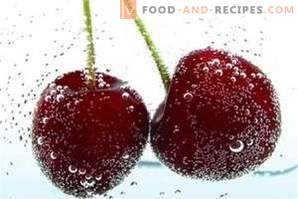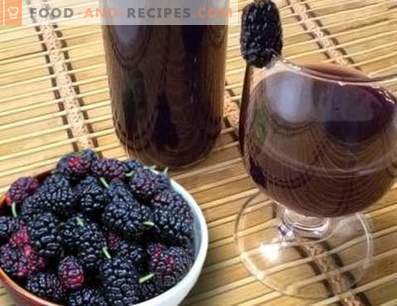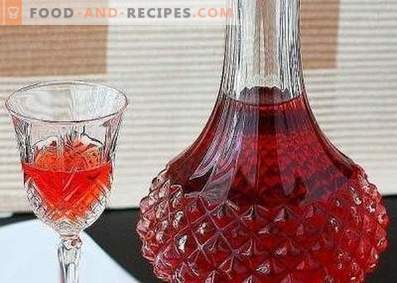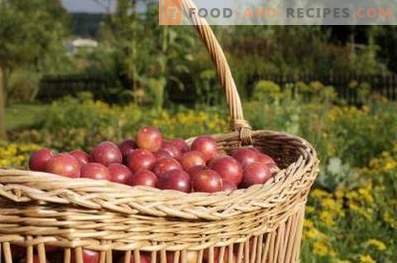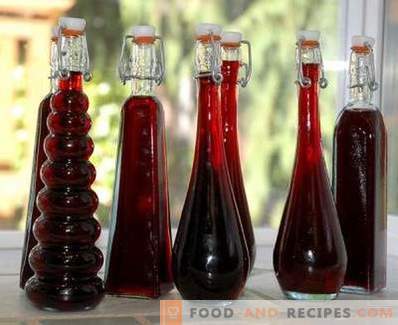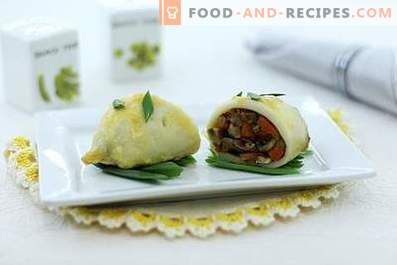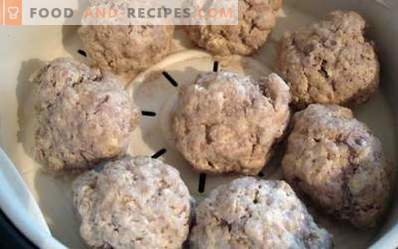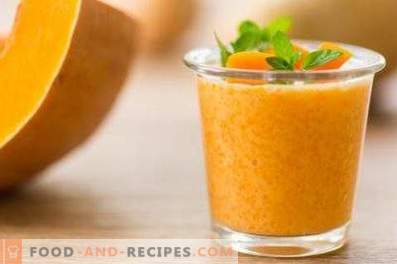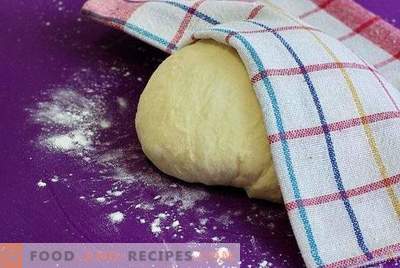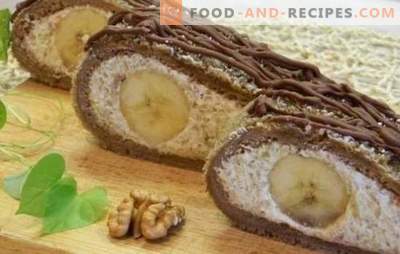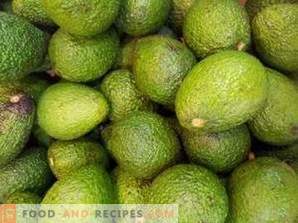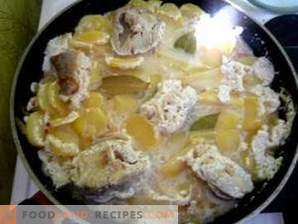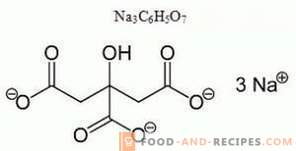
At any gala event, homemade red wine leaves first. Who would not like the aromatic, natural wine, pleasant to the taste and beautiful in color, does not contain artificial colors and chemical additives.
Making red wine at home is not so difficult.
A minimum of ingredients, a bit of effort, a little time - and here, a natural homemade wine is ready. Things are easy: to invite relatives and friends and try out a delicious home-made drink.
Red wine at home - general principles and subtleties
The first step is to prepare the container. For fermentation, purchase three, five or ten-liter jars, depending on the number of ingredients. You can put the wine in several cans. Make or buy a water seal. Do not forget about the beautiful bottles where you pour the finished wine.
Berries for making homemade red wine are different: raspberries, strawberries, cherries, blackberries, plums, cherries. The berries are not washed, natural bacteria and organisms on the surface of the fruit, interacting with sugar, start the fermentation process. Strongly dirty berries should be cleaned or not used.
It is noteworthy that the berry can be not only fresh, but also frozen and even in the form of jam. This means that it is not at all necessary to wait for the berry season to prepare homemade red wine, this can be done at any time of the year.
Additional ingredients are sugar and sometimes water. Some add alcohol-containing drinks: vodka, moonshine, alcohol. Of course, this speeds up the process of making homemade red wine, but it also gives the finished drink an extra strength and flavor of added alcohol. With natural fermentation, homemade wine from the berries is much softer, more aromatic and more pleasant to the taste.
Hydrolock for homemade wine
A device used to make homemade wine is called a water seal. It is very simple to make it at home: take a regular nylon cover, make a small hole in it, into which insert a rubber tube. That the tube did not depart and the slot was not formed, fix it with ordinary clay. The hydraulic lock can be replaced with the most common rubber glove, only in this case it is necessary to make a hole in one of the fingers. Such a device is necessary so that carbon dioxide released during fermentation can go outside. Also, it does not allow oxygen to get inside the container.
1. Red wine at home from strawberries
Aromatic, pleasant to the taste, homemade red strawberry wine is perfect for both color, as well as for refreshments and for adding to various desserts. Strawberry wine according to this recipe is made without adding water, on its own juice.
Ingredients:
• strawberries - 2 kg;
• granulated sugar - 300 grams.
Preparation:
1. Select for the preparation of homemade red wine only high quality raw materials. Berries should be ripe, not heavily contaminated.
2. Put the strawberries in the enamel bowl, carefully mash it with your hands.
3. Transfer the resulting mass to a glass container; do not fill the jar by more than two thirds.
4. Add sugar. Stir.
5. Cover the jar with a gauze cloth, remove the container in a dark place in a warm room for a week.
6. In a day or two, the fermentation process will start, on the fourth or fifth day you will see that the strawberry mass is divided into juice and berry pulp.
7. Seven days later, strain the wine into another clean glass container.
8. Put the remaining pulp in your gauze bag. Squeeze the rest of the juice as carefully as possible with your hands.
9. Connect the liquid from the pulp to the one that is already in the clean jar.
10. Put the water seal on the container. Remove the jar of fermented wine to its original place for about a month.
11. It is not necessary to influence the natural course of fermentation, that is, to shake up or move the jar.
12. After the allotted time, look, if bubbles no longer form on the surface of the wine, then the process is over. If the wine continues to bubble, leave the wine in the same position until complete fermentation.
13. Catch fertile home-made red wine into a new clean, dry jar. Close the container with a tight lid, clean for a month in a dark, slightly cool place. This period is enough to sediment lay on the bottom, leaving the clarified finished wine.
14. It remains only to carefully pour the drink into prepared bottles, trying not to jerk the jar, so as not to lift from the bottom of the sediment.
15. Seal the bottles, store in a cool place in a horizontal position.
2. Recipe for red wine from raspberry berries at home
Ingredients:
• raspberry - 2 kg;
• water - 2 liters;
• sugar - 650 grams.
Preparation:
1. Sort out the berries, crush the selected raspberries with your hands. Transfer the fragrant mass into a five-liter glass container.
2. Prepare a sweet syrup from sugar and water, cool it to 20 degrees.
3. Pour sugar syrup into the berry mass.
4. Put a water seal or glove with holes in one finger over the container's throat.
5. Remove the jar with contents to a warm dark place for two weeks. From time to time, mix the mixture with a long stick so that the berries that pop up are not moldy.
6. Strain the wine first through a sieve, pressing on the raspberries with your hands so that all the berry juice flows out. Then through the folded three to four layers of gauze and, finally, filter through cotton wool.
7. Soak red wine for another two weeks, but in a cold place.
8. Pour the finished drink into the prepared bottles, without disturbing the sediment at the bottom, seal the caps.
9. Store in a cool place.
3. Red wine from garden grapes at home
Ingredients:
• garden blue grapes - 5 kg;
• granulated sugar - 1.8 kg.
Preparation:
1. Put the berries in a large bowl, carefully crush them with your hands.
2. Cover the basin with grapes with gauze or cotton cloth, leave in this position for five days in a warm place.
3. After the allotted time, strain the mass divided into pulp and juice.
4. Mix the squeezed juice with sugar, remove the container for a couple of days in its former place to completely dissolve the sugar.
5. After two days, put a glove or water seal on the container, give the wine three weeks to ferment.
6. The completion of the process can be determined by the fallen glove or by the disappearance of bubbles.
7. Strain the finished wine into clean bottles, close the container with the lid.
8. Before use, let grape red wine brew at home in a cool place for at least one month.
4. Recipe for red wine at home from cherry berries
Ingredients:
• ripe juicy cherries - 5 kg;
• 5 liters of water;
• granulated sugar - 3.5 kg. Preparation:
1. Fold the cherry, without rinsing or removing the seed, into a suitable container.
2. Mash the berries well with your hands or with a wooden pestle for potatoes.
3. Pour the crushed cherries into a clean, dry, ten-liter bottle.
4. Pour in water, pour in granulated sugar.
5. Store the wort tank in a warm fermentation room for a week, having previously closed the throat with a hydraulic lock. Every second day, mix the wort so that it does not moldy.
6. With the help of a ladle or colander, remove the berry separated from the cherry juice, squeeze it in the same bottle, throw out the cake.
7. Leave the container in the same place for another two or three weeks, only now it can not be touched and shaken.
8. Strain the finished wine into another clean container.
9. Cover the container with a lid, put it in a cool place for a couple of weeks.
10. Cast fermented wine into beautiful prepared bottles, trying to leave all the sediment on the bottom of the container.
11. Allow about two weeks before use.
5. Red wine made from blue plum at home
Ingredients:
• blue plum - 4 kg;
• water - 3.5 liters;
• kilogram of sugar.
Preparation:
1. Sink plums, eliminating damaged and immature fruits. Remove bones.
2. Move the fruit as carefully as possible.
3. Pour in water, mix.
4. Remove the five-day weight to exfoliate the pulp.
5. Strain the drink, squeezing out all the juice from the mash.
6. Add sugar to the plum juice, mix.
7. Pour the wort into a large jar, close the throat with a water seal.
8. Store the container in a warm place for two months until the homemade red wine is fully ripe.
9. Filter the drink through cheesecloth.
10. Give plum wine another week to ripen. Only now bring wine tara in a cool place.
11. Remove the finished wine from the sediment, bottled.
6. Red wine at home from raspberry jam
If you have stocks of last year's jam, do not rush to throw it. This is an excellent raw material for making red wine at home. Following this recipe, you can make wine from any jam you have. The main thing is that it is not spoiled. Raisins are needed in order to start the fermentation process, they do not wash it beforehand, but if necessary, slightly clean it. Ingredients:
• raspberry jam - 2 liters;
• water - 4.5 liters;
• raisins - 200 grams.
Preparation:
1. In a container prepared for fermentation, mix the jam and water.
2. If the raspberry jam you have littered, heat the water slightly. Stir the mass as long as possible so that the sugar, if any, is completely dissolved.
3. Add raisins.
4. Put a glove with a hole cut on your finger over the container's throat. Remove the raspberry mass in a dark place for three weeks.
5. After the time allotted for fermentation, look if the glove slept. If yes, then the process is completed, if not - soak wine until the end of fermentation.
6. Pour the good wine in a clean, dry container, close the lid.
7. Insist on homemade red wine for another ten days, then strain and pour into beautiful bottles.
7. Recipe for currant red wine at home
Ingredients:
• kilogram of sugar;
• currant - 2.8 kg;
• two liters of water.
Preparation:
1. Do not rinse the berries, for a more astringent taste of homemade red wine you can also leave some twigs and leaves.
2. Pour the well-pressed berries with water, add sugar. Stir.
3. Having closed the container with currant mass of water seal, remove it for ten days in a warm place (25-27 degrees) for fermentation.
4. Strain the good drink into a new container, draw the wine for another week in a cool place, then remove from the sediment.
5. Pour the finished drink into prepared bottles, seal the cap. Store in the refrigerator.
8. Making red wine at home from honeysuckle
Ingredients:
• Fresh honeysuckle - 3.5 kg;
• water - 2.7 liters;
• sugar - 2.8 kg.
Preparation:
1. Crush the berries carefully.
2. Put the fragrant mixture in a glass container of a suitable size.
3. Cook sweet syrup from water and one and a half kg of sugar.
4. Pour berry mass with cooled sugar syrup, mix.
5. Remove the mass for three days in a warm place, after covering the neck of the container with gauze.
6. After three days, strain the drink, put your juice in the refrigerator.
7. Pour the remaining pulp with a liter of water, leave for three days, then strain. 8. Mix both liquids: from the refrigerator and from the settled mash in a glass jar.
9. Add a kilo of sugar. Shake the container. Pull the glove on the banks of the neck. Remove the berry liquid for a few weeks to wander in a warm place.
10. When the glove stops swelling, add the remaining 500 grams of sugar, mix. Put on a glove again, wait another week and a half to complete the process.
11. Filter the finished wine, pour into bottles, stand before use in the refrigerator for at least a week.
Red wine at home - tricks and helpful tips
• Do not use metal objects for crushing berries, the best thing is to do it with a wooden puller or with your hands.
• Choose only ripe berries, unripe inhibit the fermentation process.
• During the initial stage of fermentation, do not forget to shake the cans of wine, otherwise the pulp may mold.
• The more you put sugar, the stronger the wine you get.
• In the room where the fermentation process will take place the temperature should be from 22 to 28 degrees.
• Store the finished wine in tightly sealed bottles in a cool place, placing them in a horizontal position so that the cork does not dry out and does not lose its tightness.
